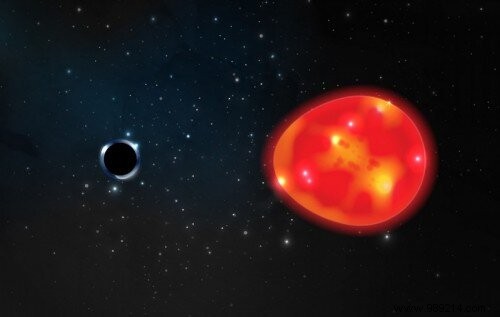A team of astronomers announces that they have identified a black hole of only three solar masses, never before seen. It is also the closest to Earth discovered to date. You will find it around a red giant 1500 light years from Earth.
About 1500 light years from our own planet evolves a black hole like no other. Nicknamed "The Unicorn", simply because the object was identified within the constellation that bears the same name, it is about three times more massive than our Sun. In other words, it is one of the lightest black holes ever recorded.
When they die, the most massive stars collapse under their own gravity and sink into the fabric of spacetime, revealing a black hole. Slightly less massive stars, on the other hand, leave behind a neutron star.
In theory, a neutron star obviously cannot exceed 2.5 solar masses. On the other hand, it was thought that the lightest black holes could not pass below the bar of five solar masses. A question then arose:what kind of object do we get inside this "mass gap"?
Then about 18 months ago, researchers at Ohio State University published a paper in the journal Science , offering strong evidence for the existence of black holes that can accommodate this mass gap. This study therefore motivated the young astronomer Tharindu Jayasinghe and his team to go hunting for these smaller objects. This work therefore led them to the Unicorn.
This black hole evolves within a binary system, alongside a giant red star. It was the presence of this star that made it possible to identify the object. Analyzing the light from the star, the researchers noted several changes in the intensity and appearance of its light at various points. In other words, "something" seemed to be tugging at the red giant, forcing it to change shape.
This pulling effect is called tidal distortion. "Just as the Moon's gravity warps Earth's oceans, producing high and low tides, the presence of a heavy object can alter the shape of one, with one axis longer than the other “, Details Todd Thompson, co-author of the study. “Here, the simplest explanation was that it was a black hole “.
The speed of the star and the way it was pulled by gravity suggested that the mass of the black hole was estimated:approximately three solar masses .

For decades it was unknown if there was something about that famous "mass gap" connecting two forms of dead stars (neutron stars and black holes). This new discovery proves that a class of "mini black holes" can indeed integrate it.
Jayasinghe and his team report the detection of their "Unicorn" in a paper accepted for publication in the journal Monthly Notices of the Royal Astronomical Society . You can read it for free at the online preprint site arXiv.org.